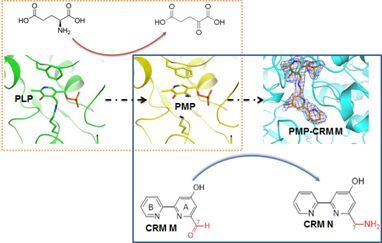Biochemical and Structural Insights into the Aminotransferase CrmG in Caerulomycin Biosynthesis
Caerulomycins (CRMs) are members of a small family of natural products containing a 2’2-bipyridyl ring core structure. CRMs have been shown to exhibit diverse bioactivities ranging from antibacterial to cytotoxic activities. In particular, CRM A was shown to exhibit novel immunosuppressive function by inducing the generation of regulatory T cells, significantly suppressing T cell activation and causing the change in the function of B cells. Very recently, CRM A was found to exert its immunosuppressive effect by targeting iron in a reversible manner. Therefore, CRM A was under development as an attractive and potent immunosuppressive drug candidate. The aminotransferase CrmG was confirmed to catalyze a key transamination reaction to convert an aldehyde group to an amino group in CRM A biosynthetic pathway. Prof Liu jinsong and his group carried out studies to investigate the functional and structural characterization of CrmG as an aminotransferase to convert an aldehyde into a primary amino group in CRM A biosynthesis.
Comparison of kinetic parameters of the CrmG reactions toward different amino acceptor substrates indicated that the CrmG-catalyzed transamination should occur before the CrmG-catalyzed O-methylation.The crystal structures CrmG in complex with cofactors PLP,PMP,or the acceptor substrate CRM M were resolved to adopt a canonical fold-typeⅠof PLP-dependent enzyme with a unique small additional domain. The structure-guided site-directed mutagenesis studies of CrmG have allowed the identification of K344 as the catalytic base for the schiff base formation and the involvement of several key amino acids in cofactor and substrate binding. Selective deletions of the additional domain afforded insoluble CrmG variants, indicating the importance of this unique domain in maintaining the right conformation of CrmG. These cumulative data provided biochemical and structural insights into the transamination mechanism of CrmG.
By gene inactivation and biochemical assays, Prof Liu and his group confirmed that CrmG was a dedicated aminotransferase to convert an aldehyde into a primary amine in the biosynthesis of CRM A. The occurrence of transamination by CrmG prior to methylation by CrmM was demonstrated by kinetic parameters of CrmG reactions. The catalytic mechanism of the CrmG reaction, similar to other aminotransferases in primary metabolism, was confirmed by three forms of CrmG crystal structures, which represented three states of the CrmG reaction cycle. Although CrmG adopts a canonical fold-typeⅠof PLP-dependent enzymes, the presence of an additional domain in CrmG, and conformational change of F207 during its catalytic cycle, made CrmG unique from other transaminases. This study adds another example of biochemical and structural demonstration of an aminotransferase modifying the scaffold of natural products.
